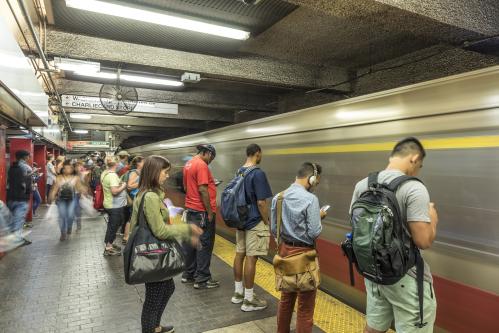Digitalization is redefining the American economy for the 21st century, and that certainly applies to the transportation sector. The massive research and development around autonomous vehicles (AVs) has implications for safety, regulation, and the overall business landscape.
But AVs are just one component of the rapid digitalization of our mobility systems. New data and telecommunications systems, new transportation and urban designs, and new pilot programs from car-sharing to scooters are all part of this tectonic shift in how we get around.
Focusing on the technologies alone, though, risks obscuring a critical question: Who will actually create, manage, and maintain AVs, other digital services, and the built environment around them?
Considering how every corner of the country relies on transportation services of some kind, digitalization within the transportation sector promises to upend labor markets everywhere. Understanding the why, who, and where of digitalization’s impacts on the transportation workforce will be critical to ensuring these innovations deliver maximum value for society. In other words, it is crucial to examine the “digital mobility” workforce in greater depth.
Jobs in digital mobility go far beyond drivers
Efforts thus far to illuminate how digitalization will affect the transportation sector have fallen short. The media frequently overstates and oversimplifies the impacts of AVs, resulting in headlines that suggest every truck driver could lose their job. Other analyses tend to focus narrowly on transportation manufacturing or driver occupations, overlooking important segments like construction, maintenance, and logistics sure to be influenced by digitalization. None looks at regional impacts. The result is a distorted picture of national and local labor markets—and an interested public still deeply unsure about exactly which jobs could be impacted.
If digital technologies really will upend our mobility systems—and if that process is only likely to accelerate over the coming decade—then we need to start using a finer touch when it comes to workforce analyses. Recent studies and industry-led partnerships have helped reorient the discussion in this direction, pointing to the extensive number of workers and training platforms implicated by changes in the years to come. Other reports have considered all the various workers where driving is essential to perform their jobs—from childcare workers to personal care aides—with estimates as high as 1 out of every 9 workers nationally.
A helpful start is to focus on those workers directly involved in overseeing and implementing the full lifecycle of automating and digitalizing our roads.
Jobs in digital mobility employ at least 9.5 million workers
To put all this in perspective—to ground what we mean by the lifecycle of automating and digitalizing our roads—let’s start with the people who already work in roadway-related industries and occupations. At minimum, there are millions of workers across hundreds of occupations in every region central to these efforts:
- If we only counted workers employed across seven different “driving” occupations—including school bus drivers; transit bus drivers; drivers/sales workers; heavy and tractor-trailer truck drivers; delivery services drivers; taxi drivers; and ambulance drivers—the potential employment impacts would stand at 3.9 million in 2017.
- However, the job of actually designing, building, and maintaining all of these new vehicle technologies falls to the wider motor vehicle industry. Employed in motor vehicle and parts manufacturing, automotive repair shops, and wholesale and retail operations, there is a whole set of other assemblers, salespersons, and mechanics that add up to another 3.8 million workers.
- But the transition to digital mobility goes far beyond driving and the motor vehicle industry. Workers in transportation-related support industries—ranging from construction laborers and highway maintenance workers, to shipping clerks and logisticians, even surveyors—will all have to manage evolving responsibilities in the digital age. These wide-ranging occupations employ another 1.8 million workers.

All told, we estimate that more than 9.5 million workers across 329 occupations in 2017—or more than 1 out of every 20 workers nationally—are likely directly exposed to changes in their work due to AVs and other digitalization. Most of these workers are not even drivers. Collectively, that means there are more workers in digital mobility than those employed in other sizable sectors like finance, real estate, or administrative services. We’re also not even counting the many people working in computing and telecommunications industries that are leading much of the R&D powering this transportation innovation.

Every state will feel impacts from digital mobility
Yet these national numbers are just a start. Depending on the specific transportation industries and occupations concentrated within their borders, states and localities could feel automation and digitalization at different rates.
What’s certain is that every state needs to be prepared. States with large transportation manufacturing sectors throughout the Midwest and Southeast, from Indiana to Alabama, employ above-average shares of their workers in transportation sectors affected by digitalization (at least 8 percent, compared to a national average of 6.7 percent). Michigan and Ohio, for their part, each employ more than 700,000 such workers.

AV and other digital changes in the transportation sector are about far more than drivers and new car plants. These numbers suggest that no state or region is immune to the labor market uncertainties these innovations are set to unleash.
Charting a new workforce strategy around digital mobility
To manage all this change, public, civic, and private sectors must forge deep, lasting partnerships to prepare the country’s workforce. Answers to a series of questions are critical to informing that work. For example:
- What are the precise industries and occupations involved in manufacturing, designing, operating, and maintaining these emerging digital technologies? Which of those occupations don’t exist today, and how many can we expect to emerge as governments and businesses deploy new technologies at greater scale? On the flip side, which jobs are most likely to disappear?
- What skills, knowledge, and training are needed for shrinking, stable, and growing positions? How can workforce development systems help new and existing workers manage this digital transition in years to come?
- Where—and how—should state and local leaders focus their workforce development efforts to seamlessly integrate these technologies and support economic opportunity? What new kinds of programs must be created, and what institutions—existing or new—should deliver them?
Nothing about the rise of automated and digital technologies suggests American roadways will be any less central to economic life in the coming decades. But we can’t spend all our time focusing on the technologies themselves or how we redesign roads and places to manage these new services. We’ve got to get our workers ready for when the technological hype becomes daily reality, and that starts with defining the specific careers in this space, emphasizing the needed skills and training, and targeting workforce development efforts at a regional scale.
The Brookings Institution is committed to quality, independence, and impact.
We are supported by a diverse array of funders. In line with our values and policies, each Brookings publication represents the sole views of its author(s).







Commentary
How big could the AV industry be? 9.5 million workers and counting
November 15, 2018